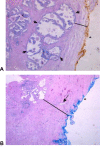Any Correlation Between Prostate Volume and Incidence of Prostate Cancer: A Review of Reported Data for the Last Thirty Years
- PMID: 34676178
- PMCID: PMC8518471
- DOI: 10.2147/RRU.S331506
Any Correlation Between Prostate Volume and Incidence of Prostate Cancer: A Review of Reported Data for the Last Thirty Years
Abstract
Purpose: Prostate cancer (PCa) is the most common non-skin cancer in men worldwide and more than 80% of men with PCa also have histo-anatomical findings of benign prostate hyperplasia (BPH). It is well documented that BPH develops in the transition zone (TZ), whereas 80-85% of PCa originates in the peripheral zone (PZ) of the prostate. Possible causal links between both disease entities are controversially discussed in the current literature. Some studies have reported that larger prostates have a decreased incidence of PCa compared to smaller prostates. The purpose of this systematic review is to comprehensively summarize studies analyzing any association between prostate gland volume and incidence of PCa.
Methods: A thorough literature review was performed between 01.01.1990 through 02.28.2020 using PubMed and applying the "PRISMA" guidelines. Inclusion and exclusion criteria were defined.
Results: Our systematic review found 41 articles reporting an inverse (negative) relationship between prostate gland volume and incidence of prostate cancer. Sample sizes ranged from 114 to 6692 patients in these single institutional and multi-institutional studies. Thirty-nine (95%) of the 41 articles showed a statistically significant inverse relationship. In our search, no study was found showing a positive correlation between BPH size and the incidence of PCa.
Conclusion: To our knowledge, this is the first systematic review on the important clinical question of interaction between prostate size and the incidence of PCa. The results are demonstrating an inverse relationship, and therefore reveal strong evidence that large prostates may be protective of PCa when compared to smaller prostates.
Keywords: benign prostate hyperplasia; inverse relationship; prostate size.
© 2021 Yamashiro and de Riese.
Conflict of interest statement
The authors report no conflicts of interest in this work.
Figures



Similar articles
-
Association Between Prostate Size and MRI Determined Quantitative Prostate Zonal Measurements.Res Rep Urol. 2022 Jun 30;14:265-274. doi: 10.2147/RRU.S362070. eCollection 2022. Res Rep Urol. 2022. PMID: 35795724 Free PMC article.
-
Association between prostate size and glandular tissue volume of the peripheral zone via novel combined MRI and histopathology: possible pathophysiological implications on prostate cancer development.Int Urol Nephrol. 2023 Apr;55(4):835-844. doi: 10.1007/s11255-023-03483-7. Epub 2023 Feb 4. Int Urol Nephrol. 2023. PMID: 36739353
-
MRI determined prostate volume and the incidence of prostate cancer on MRI-fusion biopsy: a systemic review of reported data for the last 20 years.Int Urol Nephrol. 2022 Dec;54(12):3047-3054. doi: 10.1007/s11255-022-03351-w. Epub 2022 Aug 30. Int Urol Nephrol. 2022. PMID: 36040649
-
Association between prostate size and the incidence of prostate cancer: a meta-analysis and review for urologists and clinicians.Int Urol Nephrol. 2021 Oct;53(10):1955-1961. doi: 10.1007/s11255-021-02892-w. Epub 2021 May 22. Int Urol Nephrol. 2021. PMID: 34024008 Review.
-
Histological changes of the peripheral zone in small and large prostates and possible clinical implications.Res Rep Urol. 2019 Mar 21;11:77-81. doi: 10.2147/RRU.S182781. eCollection 2019. Res Rep Urol. 2019. PMID: 30963056 Free PMC article.
Cited by
-
Shared Inherited Genetics of Benign Prostatic Hyperplasia and Prostate Cancer.Eur Urol Open Sci. 2022 Aug 1;43:54-61. doi: 10.1016/j.euros.2022.07.004. eCollection 2022 Sep. Eur Urol Open Sci. 2022. PMID: 36353071 Free PMC article.
-
Genetically predicted benign prostate hyperplasia causally affects prostate cancer: a two-sample Mendelian randomization.Transl Androl Urol. 2025 Mar 30;14(3):661-668. doi: 10.21037/tau-2024-673. Epub 2025 Mar 26. Transl Androl Urol. 2025. PMID: 40226058 Free PMC article.
-
Polygenic anti-cancer activity of Indigofera macrophylla in prostate cancer induced animal model.Toxicol Rep. 2024 Oct 22;13:101774. doi: 10.1016/j.toxrep.2024.101774. eCollection 2024 Dec. Toxicol Rep. 2024. PMID: 39554609 Free PMC article.
-
Negative magnetic resonance imaging cannot be used to omit an initial prostate biopsy - An ambispective study.Prostate Int. 2024 Sep;12(3):128-133. doi: 10.1016/j.prnil.2024.03.005. Epub 2024 Apr 4. Prostate Int. 2024. PMID: 39816937 Free PMC article.
-
Association Between Prostate Size and MRI Determined Quantitative Prostate Zonal Measurements.Res Rep Urol. 2022 Jun 30;14:265-274. doi: 10.2147/RRU.S362070. eCollection 2022. Res Rep Urol. 2022. PMID: 35795724 Free PMC article.
References
-
- Bostwick DG, Cooner WH, Denis L, et al. The association of benign prostatic hyperplasia and cancer of the prostate. Cancer. 1992;70(1 Suppl):291–301. - PubMed
Publication types
LinkOut - more resources
Full Text Sources

